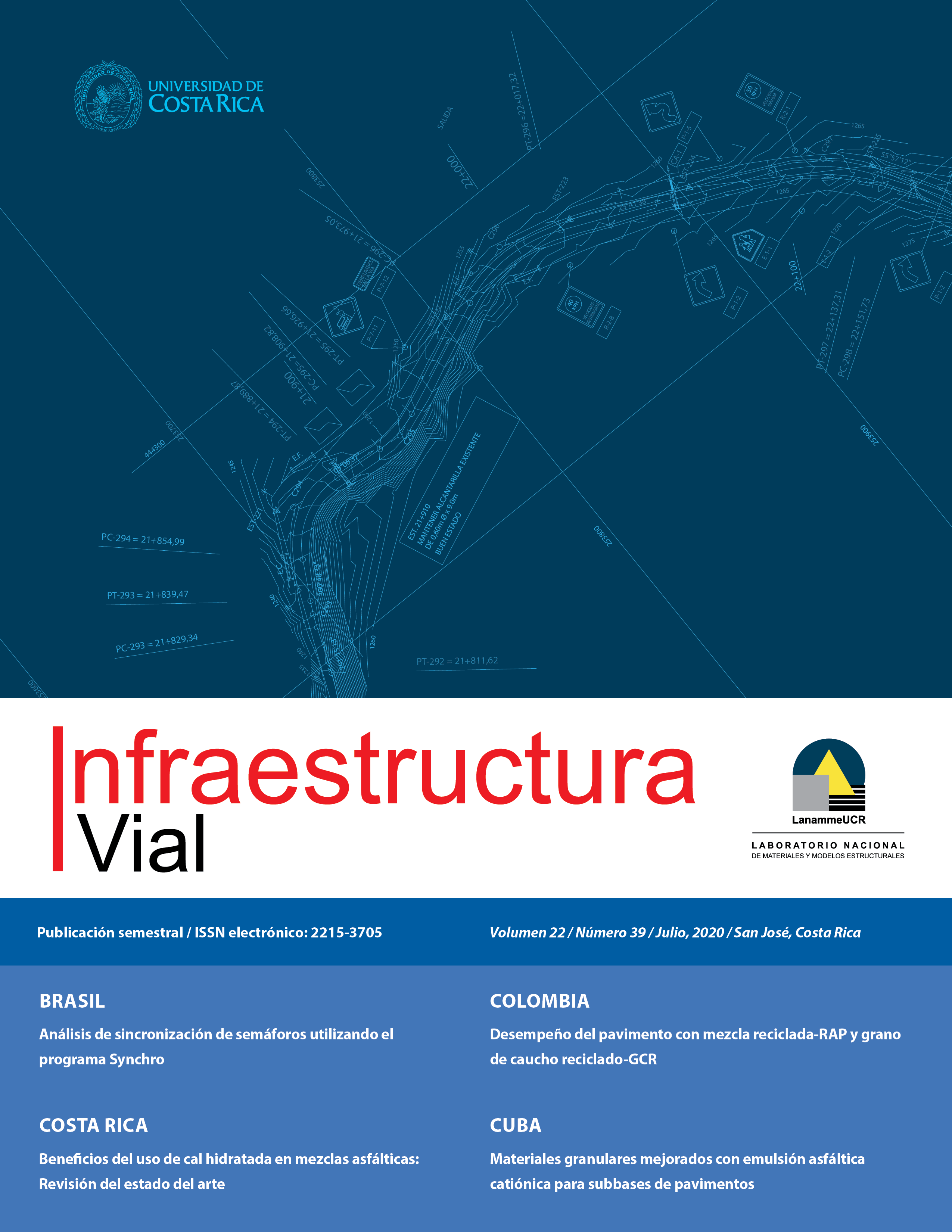Resumen
La cal hidratada es un material utilizado normalmente en las mezclas asfálticas, dado que les brinda propiedades únicas y les permite alargar su vida útil. En el presente trabajo se analizaron diversos artículos con el objetivo de comprender los métodos por medio de los cuales se agrega la cal hidratada, la cuantificación del compuesto y la mejora que éste aporta ante diversos factores adversos que acometen a las mezclas asfálticas. Se encontró que los porcentajes usuales en los que se utiliza este aditivo corresponden a un rango entre 1%-2% en peso de los agregados. Asimismo, utilizar cal como un aditivo en húmedo permite mejoras tanto en la dureza del asfalto como en la resistencia contra la humedad, del asfalto. Se concluye que la cantidad de cal hidratada que se debe agregar corresponde al 1,5% en masa de agregados debido a que, en la mayoría de estudios, con esta cantidad se obtuvo las mejores propiedades del asfalto.
Citas
Aragão, F., Lee, J., Kim, Y., y Karki, P. (2010). Material-Specific Effects of Hydrated Lime on the Properties and Performance Behavior of Asphalt Mixtures and Asphaltic Pavements. Construction and Building Materials, 24(4), 538-544. doi: 10.1016/j.conbuildmat.2009.10.005
Bastidas, J., De Carvalho, J., y Lucena, L. (2015). Optimización del contenido de asfalto modificado con cal hidratada en mezclas asfálticas densas. Revista Asfaltos y Pavimentos, 31, 55-64.
Caro, S., Masad, E., Bhasin, A., y Little, D. N. (2008). Moisture susceptibility of asphalt mixtures, Part 1: mechanisms. International Journal of Pavement Engineering, 9(2), 81-98. doi: 10.1080/10298430701792128
EuLA (2011). Hydrated Lime: A Proven Additive for Durable Asphalt Pavements Critical Literature Review. Recuperado de: https://www.eula.eu/hydrated-lime-a-proven-additive-for-durable-asphalt-pavements-critical-literature-review-paper/
Gutiérrez, L. (2017). Diseño de asfalto en caliente mejorado con el uso de cal hidratada en la Av. Camino Dibos, ICA, 2017. (Tesis de grado). Universidad César Vallejo, Lima.
Han, S., Dong, S., Yin, Y., Liu, M., y Liu, Y. (2020). Study on the effect of hydrated lime content and fineness on asphalt properties. Construction and Building Materials, 244, 1-9. doi: 10.1016/j.conbuildmat.2020.118379
Jiménez, M. (2015). Análisis del efecto de nano partículas de cal hidratada en el desempeño del ligante asfáltico. (Tesis de grado). Universidad de Costa Rica, San José.
Khattak, M., y Kyatham, V. (2008a). Mechanistic Characteristics of Moisture Damaged Asphalt Matrix and Hot Mix Asphalt Mixtures. Airfield and Highway Pavements 2008, Washington.
Khattak, M., y Kyatham, V. (2008b). Viscoelastic Behavior of Hydrated Lime-Modified Asphalt Matrix and Hot-Mix Asphalt Under Moisture Damage Conditions. Journal of the Transportation Research Board, 2057(1), 64-74. doi: 10.3141/2057-08
Kim, Y., Lutif, S., Bhasin, A., y Little, D. (2008). Evaluation of Moisture Damage Mechanisms and Effects of Hydrated Lime in Asphalt Mixtures through Measurements of Mixture Component Properties and Performance Testing. Journal of Materials in Civil Engineering, 20(10), 659-667. doi: 10.1061/(ASCE)0899-1561(2008)20:10(659)
Kollaros, G., Kalaitzaki, E., y Athanasopoulou, A. (2017). Using Hydrated Lime in Hot Mix Asphalt Mixtures in Road Construction. American Journal of Engineering Research (AJER), 6(7), 261-266.
Lesueur, D., Petit, J., y Ritter, H. (2013). The mechanisms of hydrated lime modification of asphalt mixtures: A state-of-the-art review. Road Materials and Pavement Design, 14(1), 1-16. doi: 10.1080/14680629.2012.743669
Little, D., y Petersen, C. (2005). Unique Effects of Hydrated Lime Filler on the Performance- Related Properties of Asphalt Cements: Physical and Chemical Interactions Revisited. Journal of Materials in Civil Engineering, 17(2), 207-218. doi: 10.1061/(ASCE)0899-1561(2005)17:2(207)
Moon, K., Falchetto, A., Wang, D., Riccardi, C., y Wistuba, M. (2017). Mechanical Performance of Asphalt Mortar Containing Hydrated Lime and EAFSS at Low and High Temperatures. Materials, 10(7), 1-20. doi: 10.3390/ma10070743
Mouillet, V., Séjourné, D., Delmotte, V., Ritter, H., y Lesueur, D. (2014). Method of quantification of hydrated lime in asphalt mixtures. Construction and Building Materials, 68, 348-354. doi: 10.1016/j.conbuildmat.2014.06.063
National Lime Association (2006). The Benefits of Hydrated Lime in Hot Mix Asphalt. Recuperado de: https://scholarworks.unr.edu/handle/11714/4927
Rasouli, A., Kavussi, A., Qazizadeh, M., y Taghikhani, A. (2018). Evaluating the effect of laboratory aging on fatigue behavior of asphalt mixtures containing hydrated lime. Construction and Building Materials, 164, 655-662. doi: 10.1016/j.conbuildmat.2018.01.003
LanammeUCR (2016). Daño por humedad en mezclas asfálticas (Informe LM-PI-UMP-044-R3). Recuperado de: https://www.lanamme.ucr.ac.cr/repositorio/handle/50625112500/991
LanammeUCR (2017). Daño por humedad en mezclas asfálticas (Informe LM-PI-UMP-044-R4). Recuperado de: https://www.lanamme.ucr.ac.cr/repositorio/handle/50625112500/977
LanammeUCR (2018). Daño por humedad en mezclas asfálticas (Informe LM-PI-UMP-044-R5). Recuperado de: https://www.lanamme.ucr.ac.cr/repositorio/handle/50625112500/1710
Vargas, M. (2016). Efecto en la resistencia al daño por humedad de la mezcla asfáltica en caliente al añadir cal y nano cal hidratada (Tesis de grado). Universidad de Costa Rica, San José.
Zamora, F., y Mora, E. (2019). Influencia de la cal hidratada en mezclas asfálticas drenantes (Tesis de grado). Universidad Católica de Colombia, Bogotá.



